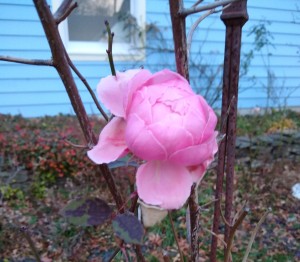 In late December many of us sing the old carol, “Lo How a Rose Ere Blooming,” but we in cold winter climates do not expect to see roses blooming in our gardens. Sometimes, though, there are exceptions. We are now heading towards late December and a rose in my garden pushed out an unexpected blossom last week. The weather is relatively balmy at this moment, but cold snaps earlier in the fall were enough to halt rose production elsewhere in the garden. The persistent rose is ‘Brother Cadfael’, a David Austin “English Rose”, and I think it just refuses to give up.
In late December many of us sing the old carol, “Lo How a Rose Ere Blooming,” but we in cold winter climates do not expect to see roses blooming in our gardens. Sometimes, though, there are exceptions. We are now heading towards late December and a rose in my garden pushed out an unexpected blossom last week. The weather is relatively balmy at this moment, but cold snaps earlier in the fall were enough to halt rose production elsewhere in the garden. The persistent rose is ‘Brother Cadfael’, a David Austin “English Rose”, and I think it just refuses to give up.
‘Brother Cadfael’ was bred in England by pioneering hybridizer David Austin, whose lifelong goal was to produce garden roses that combined old-fashioned looks and fragrance with a wider range of colors and a reliable reblooming habit. To accomplish this he crossed older varieties with newer ones until he achieved his desired results. ‘Brother Cadfael’ was the offspring of a cross between an unnamed Austin seedling and an earlier Austin variety, apricot-colored ‘Charles Austin’. The cross resulted in a beautiful, sometimes lanky shrub with large, pink blooms. When fully open, the many petals form an old-fashioned cupped shape. “Pink” is actually an inadequate description, because the strongly scented flowers shade ever so slightly to lavender. The end result is a stunning rose that reblooms freely throughout the growing season and sometimes, as in the case of my plant, beyond the growing season.
‘Brother Cadfael’ was named in honor of a fictional character created by author and historian Edith Pargeter, writing under the name “Ellis Peters”. Set in the twelfth century, the Cadfael books are mysteries focused on Brother Cadfael, a Welsh-born former Crusader who retired from combat to become a Benedictine monk. Resident at the Abbey Church of St. Peter and St. Paul, located in Shrewsbury in western England, Cadfael served as herbarian and apothecary, cultivating medicinal herbs and concocting healing potions from them. He also concocted solutions to murders that seemed to beset the Abbey with amazing regularity through the mystery series. The mysteries are sometimes formulaic, but the historical details, character development and herbal lore make them unique. Despite the murders and the mayhem that engulfed England in the twelfth century, the Cadfael books are rather gentle. The detective, an excellent observer of human nature, is more soft than hard-boiled
The Abbey was real and its ruins still stand in Shrewsbury, which is not far from the late David Austin’s home base in Shropshire. Edith Pargeter was devoted to the upkeep and care of the site. David Austin’s often named his varieties for literary or historical figures and his regard for the location, author and character resulted in the christening of the distinctive rose. English actor Derek Jacobi, who played Cadfael in film adaptions, reportedly grows the Cadfael rose in his garden.
In the gardening world and the world at large, everything eventually comes full circle. Just as Edith Pargeter reached back in time to create Cadfael, David Austin reached back in rose history to create the ‘Cadfael’ rose. One of ‘Cadfael’s’ ancestors—the equivalent of a rose great-grandfather—was a French variety, ‘Duchesse de Montebello’, introduced in 1824. ‘Duchesse’ is classified as a hybrid Gallica rose, meaning that it was descended from a distinct species, Rosa gallica. Though the name “gallica” means “French”, the species itself was cultivated as far back as Greek and Roman times, and is also known as “the apothecary rose”. The rose may have travelled to Europe with conquering Roman legions, or it may have arrived slightly later with returning Crusaders. In any event, the fictional Cadfael knew and used it in his apothecary duties. Roses are mentioned many times in the mystery series, as the real Cadfaels of the time included rose petals, rose oil and other rose products in all kinds of internal and external remedies.
The highly scented gallicas also made things smell better at a time when foul odors of varying intensity were major components of everyday life.
Edith Pargeter died in 1995 and David Austin left the world in 2018, but Brother Cadfael lives on amid garden greenery and the dust of used bookstores. At a moment when it seems as if darkness is ascendant, I like the fact that Cadfael’s rosy namesake also lives long and blooms abundantly in the intermittent sunshine of my small corner of the horticultural world.
